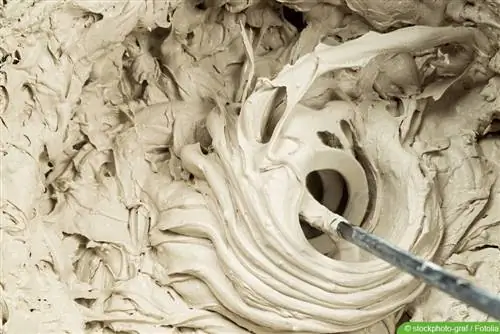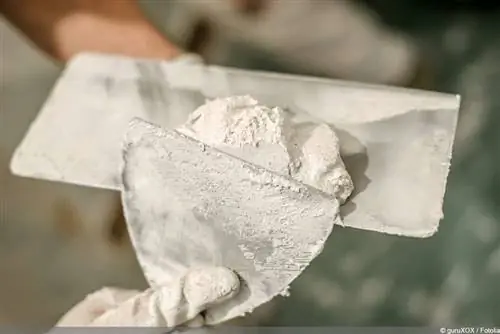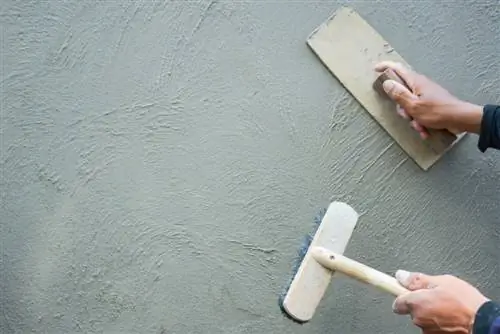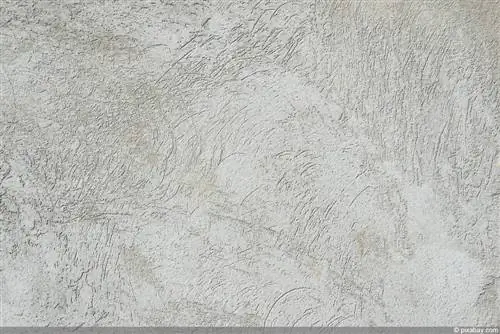- Author admin [email protected].
- Public 2023-12-17 03:39.
- Last modified 2025-10-04 22:41.
Gypsum is probably still the most important building material when it comes to repairs and renovation work in the house or apartment. If you follow the respective instructions, plaster processing should not be a problem. However, for many people, mixing the mixture is difficult. It's actually child's play if you follow a few basic rules and, above all, the instructions for use carefully.
Types of plaster
For plaster work to work, it is very important to choose the right type of plaster. This depends on the task that needs to be completed. It is important to distinguish between the following variants:
- Standard plaster for filling cracks, holes and joints (tough, almost mortar-like consistency)
- Surface plaster for a stable, smooth surface on walls (less tough consistency)
- Plaster Plaster as mortar and for plastering (spreadable consistency)
- Stucco plaster for creating decorations (soft, somewhat liquid consistency)
- Modeling plaster for fine and artistic work (soft, somewhat liquid consistency)
- Electrician's plaster for filling sockets or fixing cables (somewhat tough consistency)
There is also the so-called hard plaster, which is usually only used in connection with dental technology.
Note:
The exact type of plaster is not always stated on the packaging. However, there is usually information about the work the material is suitable for.
Basic rules
Mixing the mass is basically the same for all types of plaster. Two basic rules must be observed. If you don't do this, there is a risk that the mass will clump or not bind properly.
Rule 1
Always stir the gypsum powder into the water! The container for mixing is first filled with water, into which the powder can then be stirred. If you first fill in the powder and then pour water on it, this will definitely lead to the formation of lumps. It is also important that the plaster trickles quickly into the water and is mixed immediately. Air bubbles must be avoided at all costs.
Rule 2
Let the mass swamp! After the gypsum powder has been completely stirred in, the mixture must sit quietly for about a minute. This process is called swamping. Without this swamping, the binding ability of the plaster may suffer.
Note:
You should always work very quickly when mixing the plaster mass, otherwise it can bind to the bottom of the vessel while the part above is still very liquid.
Instructions
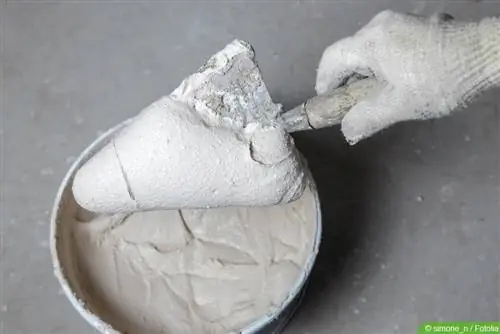
Before mixing, it is important to choose the right container. The most important thing is the right size. It must be possible for the gypsum powder and the water to be mixed without spilling over.
Step 1: Determine the mixing ratio
The correct ratio of gypsum powder and water is crucial for success. The rule of thumb is three or four parts gypsum powder to one part water. However, it is better to follow the instructions on the packaging. There you will also find information about the amount of powder required for a certain amount of mass. Also important: always only mix as much as can be processed within 15 to 20 minutes.
Step 2: Measure quantities accurately
The amounts of powder and water must be measured precisely. The plaster is weighed. It is best to use a measuring cup for the water.
Step 3: Fill the container
The container for mixing the mixture is first filled with cold water. An upper edge of at least five to ten centimeters should remain water-free. You're on the safe side if the container is only about 75 percent full of water.
Step 4: Mix plaster
The gypsum powder is quickly poured into the water while stirring at the same time with a wooden spatula or an old spoon. Stirring deeply down to the bottom is important.
Step 5: Swamp
After stirring in the powder, allow the mixture to rest for a minute so that it can bind.
Step 6: Continue stirring
After the short break, the plaster mass is mixed further until it has achieved full binding. Here, too, it is important to stir as quickly as possible. There should be two to three stirring revolutions per second. It usually takes about two minutes until a well-binding and lump-free mass is created, which can then be processed immediately.
Tip:
Air bubbles in the mixture must be avoided at all costs. That's why you shouldn't stir too quickly, as this will inevitably lead to more air being introduced.
Calculation work
As already mentioned, it is very important that the mixing ratio between gypsum powder and water is correct. To do this, you absolutely have to know how much of each you need. The relevant information can be found on the packaging. They each depend on the plaster mass required. This must definitely be assessed in advance. Based on the quantities on the packaging, you can then calculate how much powder and water you need for the individual amount. Consequently, it doesn't work without calculation work. However, it is not every single gram or every single milliliter that matters.
General mixing ratio
The right mixture between gypsum powder and water is a field that is as broad as it is difficult. A huge number of factors play a role here. Unfortunately, general statements about the individual types of plaster are not possible. And even with the same type of plaster, there can be differences from manufacturer to manufacturer. Anyone who works with plaster can hardly avoid experimenting a bit. After a relatively short time, however, you get a good feeling for what the relationship should be like. Since plaster costs relatively little, even one or two failed attempts are not a catastrophe.

